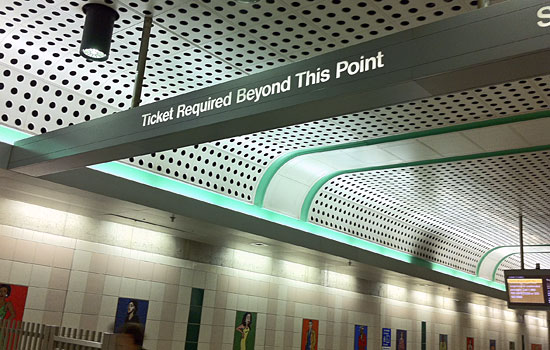Ticket sales rise when subways locked
November 17, 2011

With Metro testing locked subway turnstiles, signs like this one in the Civic Center station take on new importance.
As thousands of L.A. subway riders have learned in recent weeks, honesty is the best policy—especially when somebody’s watching to see whether you paid to ride.
Recent testing to determine the financial impact of locked turnstile gates at four stations, including ticket checks by uniformed inspectors, boosted vending machine sales of day passes and one-way fares by about 50% while gates were locked.
“It was apparent many customers were using [ticket vending machines] for the first time,” according to a report to the agency’s Board of Directors.
As ticket sales went up, overall station entries decreased by 10% during the testing period as some travelers were apparently deterred by the locked gates and presence of ticket-checking staff.
Nevertheless, vending machine revenue was up 35%, the report said. Over time, as customers became accustomed to locked gates, that boost could be expected to level off, perhaps settling around 20%.
The gate-locking trial run also has had financial implications for the traveling public; dozens have been hit with citations carrying fines of up to $250 for riding without a ticket or pass.
The testing comes as Metro continues moving away from its original honor-system approach on the subway toward the locked turnstile set-up common in other large cities such as New York and San Francisco.
The conversion started in 2008, when Metro’s board approved a 10-year, $46 million lease contract to retrofit the Red Line, the Purple Line and some light rail stations with barrier gates—both as a security measure and as a way to recoup lost revenues estimated at the time to be about $5.5 million a year.
Since the gates were installed, however, some have questioned whether the cost of monitoring a locked subway system would outstrip any gain in revenues.
The report did not specifically address that issue, but said the preliminary revenue findings were “quite positive.”
More testing is needed, the report said, to see if patterns hold true when gates are locked during peak travel hours, from 1 p.m. to 6 p.m. To that end, a new round of locked-gate testing started Oct. 26 and is expected to continue through January 11, 2012. Upcoming stations targeted for the tests are UniversalCity, North Hollywood, Hollywood/Vine, Civic Centerand 7th/Metro.
In conjunction with the locked gate testing, Metro is heavily promoting use of its TAP cards, which can serve either as transit passes or as stored-value cards from which funds are deducted each time they’re used. The TAP cards aren’t just quick and convenient for riders; they also enable the agency to keep better track of ridership and ensure that everybody’s paying their way.
But there are challenges because some 40% of riders surveyed did not use the cards, or had transferred from other transit agencies that are not yet part of the TAP system.
Even among the 60% of customers with TAP cards, there were issues.
Up to half did not tap their pre-paid cards unless “encouraged” to do so, the report said. And when the turnstiles were in their usual “free-spin” mode, only 25% bothered to tap.
Posted 11/17/11












 405 bridge work causes a stink
405 bridge work causes a stink

